Yikes! Fox and rodent battle is top wildlife photo
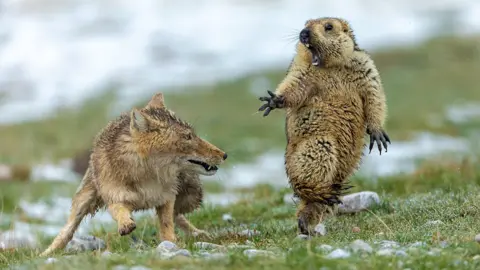 Yongqing Bao
Yongqing BaoIt looks like it ought to be the subject of a funny caption competition but this picture taken in China's Qilian Mountains is deadly serious.
The fox has surprised the marmot and a fight is about to begin that will result in the rodent being killed.
Not even the intervention of the marmot's mother can change the outcome.
"That's nature," says Yongqing Bao, whose striking image has earned him the top prize in the 2019 Wildlife Photographer of the Year competition.
The shot also meant Yongqing got to share the award for the best picture in the mammal behaviour category.
Persistence pays when you are a wildlife photographer, and Yongqing had to stake out an alpine meadow on the Qinghai-Tibet Plateau for several hours to be in position to catch the action.
The fox had lain very still, hoping to trap a passing marmot unawares. It worked a treat. In one of the more gruesome frames on Yongqing's camera, the fox has the young rodent's head in its mouth.
Roz Kidman Cox was the chair of judges. "The WPY competition has behaviour entries like no other. The world's top photographers in the field of animal behaviour always enter, and I have to say this image is one of the best I've ever seen," she told BBC News.
This year's junior grand prize winner is Cruz Erdmann for his night-time image of a bigfin reef squid in the Lembeh Strait off North Sulawesi, Indonesia. Cruz had entered in the 11-14 years category.
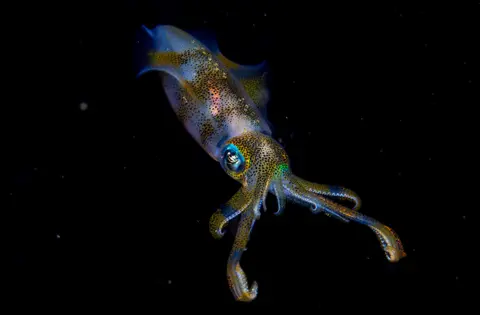 Cruz Erdmann
Cruz Erdmann
Getting a clear shot of the iridescent cephalopod takes a good deal of technical prowess. "You have to be careful not to stir up the silt when you dive or you'll get a lot of backscatter from the strobe light. I wasn't kicking with my legs so that's why the photo seems very clear," he said.
WPY, as it's often called, is one of the most prestigious competitions of its type in world photography.
Started in 1964, the competition is now organised by London's Natural History Museum.
An exhibition of the best images opens at the South Kensington institution on Friday. Next year's competition starts taking entries from Monday.
Scroll down for some of the other category winners.

Land of the eagle by Audun Rikardsen, Norway
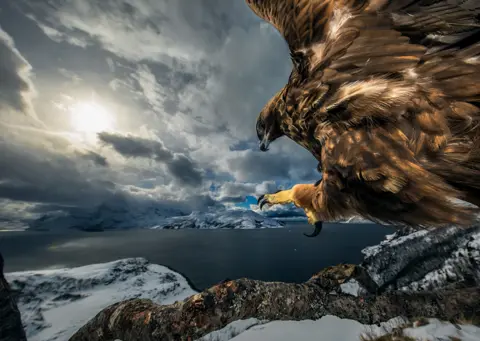 Audun Rikardsen
Audun Rikardsen
Winner 2019, Behaviour: Birds. This shot took Audun three years to achieve. He'd carefully placed an old tree branch in a position where the golden eagles would come into land. A camera and flash would trigger as soon as a bird set down.
Audun recalled: "They became so used to the flash going off, it didn't seem to bother them. I think they like having their picture taken." Crows would do it as well, but that wasn't quite the picture the Norwegian photographer was after.

The huddle by Stefan Christmann, Germany
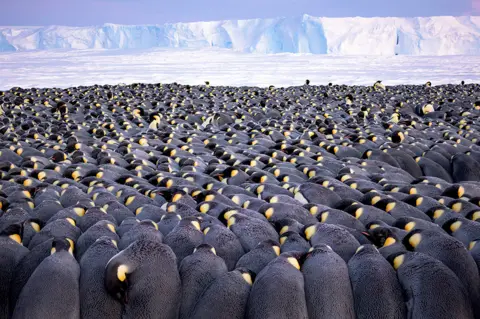 Stefan Christmann
Stefan Christmann
Winner 2019, Wildlife Photographer of the Year Portfolio Award. The toughest of the tough. More than 5,000 emperor penguins gather together in their classic huddle formation to beat the wind and late winter cold on the sea-ice in front of the Ekström Ice Shelf in East Antarctica. These are male birds incubating eggs at their feet. The females have gone to sea to forage.

The rat pack by Charlie Hamilton James, UK
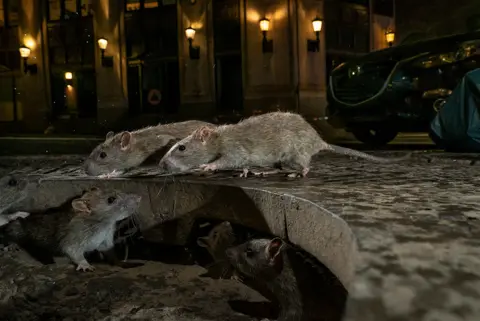 Charlie Hamilton-James
Charlie Hamilton-James
Winner 2019, Urban Wildlife. Charlie was on an assignment for National Geographic, to photograph the rats of the world. This group he found in the Wall Street district of Manhattan, New York.
The rodents were living under a grill that surrounded the base of a tree. At night they'd run over to the rubbish bins outside a hotel to feed. Charlie set up his camera and fired the shutter with a remote trigger from a couple of metres away.
"There were probably 30 rats living under the grate. They became so used to me over three days that one of them came and stood on my foot," Charlie said.

The architectural army by Daniel Kronauer, USA
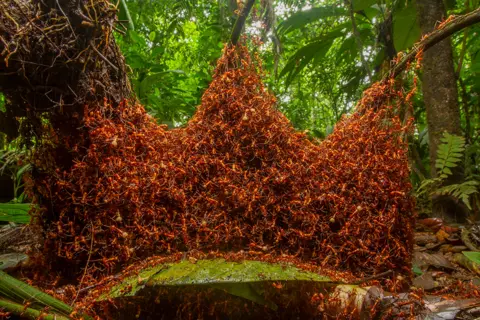 Daniel Kronauer
Daniel Kronauer
Winner 2019, Behaviour: Invertebrates. These army ants in Costa Rica don't build a nest in the earth or in an old tree. Instead, they construct it out of their own bodies, hanging from branches in interlocking chains. Inside, are passageways and chambers where they protect their queen and nurture their young.
"Pretty much every day they disassemble this structure; it just melts away and they carry the larvae across the rainforest, setting up a new bivouac maybe 150m away," Daniel said. "It's beautiful. I thought this nest looked like a crown or a cathedral."

Snow exposure by Max Waugh, USA
 Max Waugh
Max Waugh
Winner 2019, Black and White. No WPY is complete without a good "whiteout" image. This one of a bison was captured in Yellowstone National Park. The bison wants to get at the buried grasses and sedges and so makes a hole by brushing its face from side to side.
"I'd been in situations like this before where I'd played around with slower shutter speeds," said Max. "I think that's part of what makes this a good picture - the snow is blurred. I just waited until the bison lifted its head and fired off a few shots."

Snow-plateau nomads by Shangzhen Fan, China
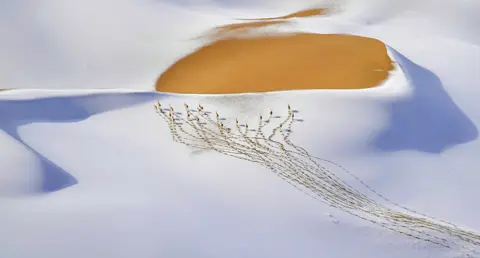 Shangzhen Fan
Shangzhen FanWinner 2019, Animals in Their Environment.
A small herd of male chiru are seen crossing a snow-covered slope in the Kumukuli Desert of China's Altun Shan National Nature Reserve. These antelope live at altitudes up 5,500m where temperatures can fall to -40C. "They like to get to the patches of bare sand because that's where it is warmest," says Shangzhen. The photographer took this image from a kilometre away. In the same sequence, he saw two bears moving across a ridge.

[email protected] and follow me on Twitter: @BBCAmos
